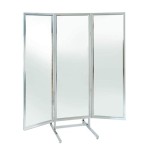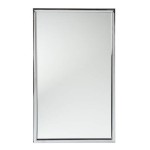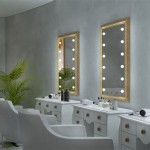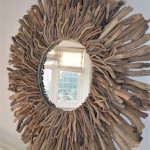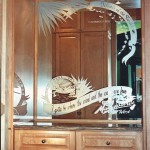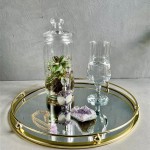Mirror For Shower: A Comprehensive Guide
A shower mirror is a specialized mirror designed for use within the humid and often steamy environment of a shower. Unlike conventional mirrors, which are prone to fogging and deterioration in such conditions, shower mirrors are engineered to resist these effects, providing a clear reflection during and after a shower. This functionality makes them particularly useful for tasks like shaving, applying facial products, and general grooming.
The demand for shower mirrors has grown substantially due to their convenience and impact on personal care routines. Individuals seek efficient and effective solutions for grooming within the shower, and shower mirrors offer a practical answer. The evolution of shower mirrors has led to a variety of designs, materials, and technologies aimed at maximizing usability and longevity in the challenging shower environment.
Several factors differentiate a shower mirror from a standard mirror. These differences primarily revolve around the ability to withstand humidity, resist fogging, and adhere securely to shower surfaces. The materials used, the construction methods, and the incorporation of special coatings or technologies are all critical considerations in the design and selection of a shower mirror.
Understanding Fog Resistance Technologies
One of the most significant challenges in designing a shower mirror is preventing fogging. Fog occurs when warm, humid air comes into contact with a cooler surface, causing water vapor to condense into tiny droplets. This condensation scatters light, obscuring the reflection. Shower mirrors employ various techniques to combat this phenomenon.
The simplest approach involves applying an anti-fog coating to the mirror surface. These coatings typically consist of a hydrophilic material that attracts water. Instead of forming droplets, the water spreads out into a thin, transparent film, thus preventing fogging. The effectiveness of these coatings, however, can diminish over time, especially with frequent cleaning and exposure to harsh chemicals.
Another method involves heating the mirror surface. A heated mirror maintains a temperature slightly above the surrounding air, preventing water vapor from condensing. These mirrors typically use a low-voltage electrical element to generate heat and require a power source within the shower or bathroom. Heated mirrors tend to be more effective at long-term fog prevention but also introduce the complexity of electrical wiring and potential safety considerations.
A less energy-intensive approach involves creating a double-sided mirror with a chamber behind the reflective surface. This chamber is filled with warm water prior to showering. The warm water heats the mirror surface, preventing fogging for the duration of the shower. This type relies on the user to actively prepare the mirror before each use, but it eliminates the need for electrical power.
The choice of fog resistance technology will depend on factors such as budget, ease of installation, and desired level of performance. Coatings are usually the most affordable option, while heated mirrors offer the most reliable fog prevention. Water-filled mirrors represent a compromise between cost and effectiveness.
Material Selection and Durability
The materials used in constructing a shower mirror significantly impact its durability, resistance to corrosion, and overall lifespan. Common materials include acrylic, glass, and stainless steel.
Acrylic mirrors are lightweight and shatter-resistant, making them a safe option for shower environments. They are generally less expensive than glass mirrors. However, acrylic is more susceptible to scratching and may distort the reflection slightly over time. The surface can also become hazy with prolonged exposure to humidity and cleaning agents.
Glass mirrors offer a clearer and more accurate reflection compared to acrylic. They are also more resistant to scratching. However, standard glass is vulnerable to breaking upon impact. Tempered glass, which is significantly stronger and shatters into small, relatively harmless pieces, is a safer alternative for shower environments. Glass mirrors are often treated with a protective coating to enhance their resistance to corrosion and water damage.
Stainless steel mirrors are highly durable and resistant to corrosion, making them a long-lasting option for wet environments. They are also shatter-resistant. However, stainless steel mirrors can be more expensive than acrylic or glass mirrors. The reflective surface of stainless steel may not be as clear as that of glass, potentially leading to a slightly less defined reflection.
The choice of material should consider the desired balance between cost, durability, safety, and optical clarity. For a budget-friendly and shatter-resistant option, acrylic may be suitable. For superior reflection quality and durability, tempered glass or stainless steel may be preferred.
Installation and Mounting Options
The installation process for a shower mirror is an important consideration. Various mounting options are available, each offering different levels of security and ease of installation.
Suction cups are a common and convenient mounting method. They require no drilling or permanent alterations to the shower walls. However, the holding power of suction cups can vary depending on the surface material and the quality of the suction cups themselves. They may not be suitable for textured or uneven surfaces and may occasionally require re-attachment.
Adhesive strips offer a more secure alternative to suction cups. These strips use a strong adhesive to bond the mirror to the shower wall. They are generally more reliable than suction cups, but they may still fail under extreme conditions or with repeated exposure to moisture. Removal of adhesive strips can also be challenging and may leave residue or damage the surface.
Screw-mounted mirrors provide the most secure and permanent installation. They require drilling holes into the shower wall and anchoring the mirror with screws. This method ensures a stable and long-lasting attachment, but it also necessitates more effort and skill to install. It is crucial to select screws and anchors that are appropriate for the wall material and to seal the holes properly to prevent water damage.
The choice of mounting method depends on the user's comfort level with installation, the type of shower wall, and the desired level of security. Suction cups are ideal for temporary or non-permanent installations, while screw-mounted mirrors offer the most secure and durable solution. Adhesive strips provide a compromise between ease of installation and holding power.
Beyond the core functionality of fog resistance, durable materials, and secure mounting, several other factors can influence the user experience with a shower mirror. These include size, shape, adjustability, and integrated features.
The size of the mirror should be appropriate for the intended use and the available space. A larger mirror provides a wider field of view, which can be useful for tasks like shaving or applying facial products. However, a larger mirror also requires more surface area for mounting and may be more prone to fogging if the fog resistance technology is not adequate.
The shape of the mirror can also affect its usability. Rectangular mirrors are a common choice, offering a traditional and versatile design. Round mirrors provide a softer aesthetic and may be easier to adjust. Oval mirrors combine elements of both rectangular and round shapes.
Adjustability allows the user to position the mirror at the optimal angle for viewing. Some mirrors feature a swivel or ball joint that allows for tilting and rotation. This adjustability can be particularly useful for individuals of different heights or for performing tasks at different angles.
Some shower mirrors incorporate additional features, such as integrated lighting, magnifying lenses, or storage compartments. Lighting can improve visibility in the shower, while magnifying lenses can be helpful for detailed tasks like eyebrow shaping. Storage compartments can provide a convenient place to store razors, shaving cream, or other personal care items.
In selecting a shower mirror, it is important to consider the specific needs and preferences of the user. Factors such as the size of the shower, the frequency of use, the desired level of performance, and the budget should all be taken into account.
Proper maintenance is crucial for extending the lifespan and maintaining the performance of a shower mirror. Regular cleaning with a mild, non-abrasive cleaner can help to prevent buildup of soap scum and hard water deposits. Avoid using harsh chemicals or abrasive scrubbers, as these can damage the mirror surface and reduce the effectiveness of any anti-fog coatings.
For mirrors with anti-fog coatings, it is important to follow the manufacturer's instructions for cleaning and maintenance. Some coatings may require occasional reapplication to maintain their effectiveness. For heated mirrors, ensure that the electrical connections are properly sealed and protected from water damage.
The shower mirror market offers a wide range of options to suit different needs and budgets. By understanding the key features and technologies involved, consumers can make informed decisions and select a shower mirror that provides years of reliable service and enhances their personal care routine.

Aqua Fog Free Mirror Electric Lighting Company

5 Best Fogless Shower Mirrors Of 2024 Reviewed

Acclaim Fog Free Mirror Electric Lighting Company

Aqua Fog Free Mirror Electric Lighting Company

Suction Fogless Mirror White Oxo Softworks Target

Acclaim Fog Free Mirror Electric Lighting Company

Acclaim Fog Free Mirror Electric Lighting Company

Clearmirror Luxury Heated Mirrors Shelves

Clear Shower Mirrors Won T Fog Up

Aqua Fog Free Mirror Electric Lighting Company
